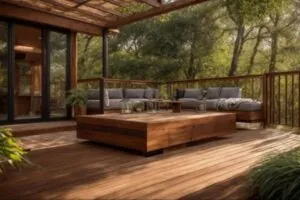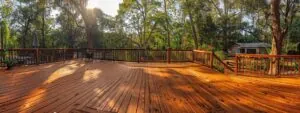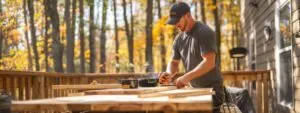Selecting the suitable decking material is crucial for enhancing your outdoor space. With various options offering unique benefits, making the right choice can be challenging. You’ll need to consider factors like durability, maintenance, and the overall look you want. From low-maintenance composite decking to the classic appeal of hardwood, understanding your options will help you make an informed decision. This article will list the top decking materials to guide your selection process.
Understanding the Importance of Deck Material Selection
Choosing suitable deck materials is essential for creating a deck that aligns with your needs and preferences. The material you select will impact the deck’s appearance, maintenance requirements, and overall lifespan. A well-chosen material can enhance your outdoor space’s durability and aesthetic appeal, making it a practical and long-lasting addition to your home. Knowing the different material options is crucial for making an informed decision and ensuring your deck remains functional and attractive for years.
Exploring the Top Decking Material Options
When considering the types of decking materials, PVC decking is a reliable option due to its high durability. Made from polyvinyl chloride, this synthetic material is designed to resist rot, splintering, and insect damage, making it ideal for outdoor spaces that endure heavy use. PVC decking also requires minimal maintenance compared to natural wood, as it doesn’t need staining or sealing to retain its appearance. Understanding the structural requirements, such as the strength and spacing of the joist framework, is crucial when working with this material to ensure the deck’s stability and longevity.
I. Composite Decking
Composite decking offers a low-maintenance solution for homeowners who desire the look of wood without the upkeep. Made from a combination of recycled plastics and wood fibers, composite decking resists mold, rot, and insects better than traditional wood. Although it may require a higher upfront investment, its durability, and minimal maintenance can save time and money in the long run.
A. Advantages and Disadvantages
Composite decking offers significant advantages, including resistance to mildew, ensuring a clean and long-lasting surface. Its durability keeps the original color vibrant, eliminating the need for frequent maintenance. Many composite planks are designed for use with specialized screws and hidden fasteners, providing a seamless, nail-free finish. The material’s blend of wood fibers gives it a familiar texture underfoot, combining the aesthetic appeal of wood with the low-maintenance benefits of synthetic materials, making it a popular choice for modern decks.
B. Cost and Lifespan
Composite decking represents a cost-effective investment due to its long lifespan. While the initial cost may be higher than some alternatives, this material’s resistance to heat, water, warping, and fading ensures that it endures over time. Many manufacturers back their products with extended warranties, reflecting confidence in the material’s durability. This resilience means fewer repairs and replacements, offering homeowners long-term value. Composite decking’s ability to maintain its appearance and structural integrity makes it a practical, budget-friendly option.
You might like: What is the Cost of a Deck For an Above Ground Pool?
II. Pressure-Treated Wood Decking
Pressure-treated wood decking is a popular and cost-effective option for outdoor spaces, providing a durable foundation for areas exposed to moisture, pests, and heavy use. This wood undergoes chemical treatment to enhance its resistance to decay, making it a reliable choice for various applications. Treated wood is durable and long-lasting and more than pays for itself in the long run over time.

A. Advantages and Disadvantages
Pressure-treated wood decking offers a budget-friendly option with enhanced resistance to rot, decay, and insects. The chemical treatment process adds durability, often supported by a warranty. However, this type of decking requires ongoing maintenance, including sealing and staining, to maintain its appearance and structural integrity. Over time, it may also be prone to warping or splintering, especially if not adequately cared for. While the initial cost is lower, the long-term maintenance needs should be considered when choosing this material.
B. Cost and Maintenance
Pressure-treated wood decking is initially affordable, but its long-term costs can add up due to the necessary upkeep. Regular cleaning, sanding, and sealing are required to preserve the wood’s appearance and prevent moisture damage. The wood may become prone to splintering, warping, and fading without proper maintenance. Pressure-treated wood requires regular maintenance, including sealing and staining, to protect it from the elements and keep it looking its best. Despite these needs, it remains a viable choice for those seeking a balance between cost and durability.
V. Hardwood Decking
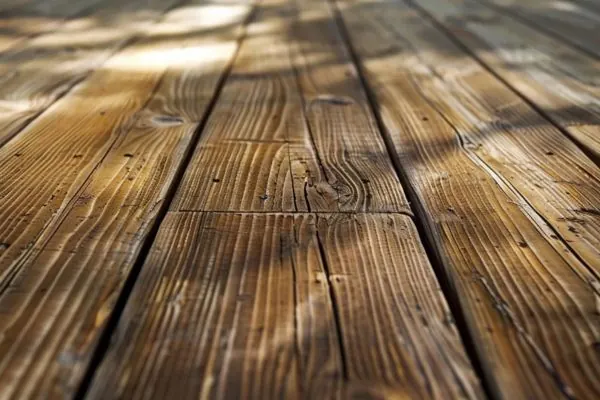
Hardwood decking offers a premium option for those desiring real wood’s natural beauty and durability. Known for its rich grain patterns and natural colors, hardwood is a popular choice for outdoor spaces where aesthetics matter. Understanding the pros and cons of different hardwoods helps make an informed decision, balancing beauty needs with practical concerns like maintenance, cost, and long-term durability.
A. Advantages and Disadvantages
Hardwood decking is prized for its natural elegance and durability, making it a top choice for upscale outdoor spaces. Its rich texture and warmth enhance any patio or deck, offering a timeless appeal. However, hardwood can be more challenging to maintain, requiring regular treatments to preserve its appearance and protect against weather damage. Hardwood tends to be more expensive than other decking materials, and upkeep can be labor-intensive, especially in areas with heavy foot traffic or harsh weather conditions.
B. Cost and Care
Investing in hardwood decking involves higher upfront costs and ongoing maintenance to keep it looking its best. Regular cleaning, sealing, and refinishing are necessary to protect the wood from moisture, UV rays, and general wear year after year. This care extends the life of the deck and maintains its visual appeal. Despite the need for consistent upkeep, hardwood’s longevity and aesthetic value often justify the investment, providing a beautiful, durable outdoor space that can withstand the elements for years to come.
VI. Factors to Consider to Make the Right Decision for Your Deck
Choosing the best materials for decks involves more than just selecting an appealing option; it requires careful consideration of various factors. The deck’s location is crucial, as environmental conditions like sunlight and moisture can significantly impact material durability. The deck size also influences material choice, with larger decks needing cost-effective yet stable options. Additionally, the home’s architectural style should harmonize with the deck’s design. Balancing cost with maintenance requirements ensures that the chosen material offers long-term value and satisfaction.
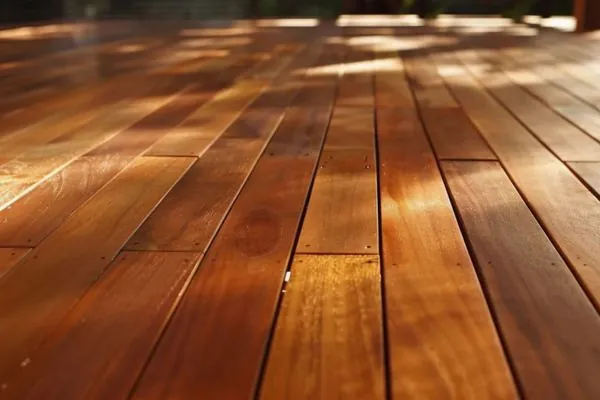
A. Location
The location of your deck is critical when choosing suitable material. Decks exposed to harsh weather, like intense sunlight or heavy rain, need materials that can withstand these conditions, such as composite or PVC. In contrast, more sheltered areas might benefit from the natural beauty of wood. Understanding your local climate and how it affects different materials can help you select a deck that will remain functional and attractive over time. Location-specific considerations are essential to ensure your deck’s longevity and usability.
B. Deck Size
The size of your deck plays a significant role in determining the best material. Larger decks often require more affordable and easier-to-install materials like pressure-treated wood or softwood. These options can reduce the overall cost without sacrificing stability. However, the choice of material must also consider how it will hold up over time, especially in larger deck installations where durability is critical. Evaluating the cost-effectiveness and long-term maintenance of the material is essential when planning a sizable deck project.
C. Architectural Style
Your deck should complement your home’s architectural style. Materials like steel or sleek composites may be ideal for a modern home, adding a contemporary touch. In contrast, traditional homes might benefit from the warm, rich tones of hardwoods like mahogany. Choosing a material that aligns with your home’s style enhances its aesthetic appeal. However, ensuring this choice fits your budget is also essential, balancing visual harmony with financial practicality.
D. Budget and Maintenance
When budgeting for a deck, consider the initial cost of materials and the ongoing maintenance required. While some materials, like composite decking, may have a higher upfront cost, they often require less maintenance over time, saving money in the long run. On the other hand, cheaper materials may lead to higher repair and upkeep costs, turning a budget-friendly option into a more expensive choice over time. Careful budgeting and consideration of maintenance needs are crucial to making an intelligent investment in your deck.
VII. All Pro Cape May Deck Builders Can Help You Build the Perfect Deck
At All Pro Cape May Deck Builders, we recognize that selecting the suitable material for your deck is crucial for your budget and longevity. We’re committed to helping you create your dream deck using durable and cost-effective materials. Our professional builders and designers will be with you every step of the way, ensuring that your vision is brought to life.
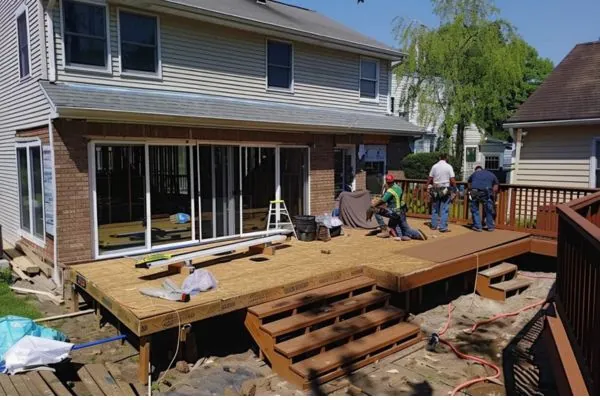
Whether designing a deck to enhance an outdoor kitchen or simply adding an inviting outdoor space, choosing materials that balance beauty and functionality is essential. Our skilled builders are experts at integrating decking materials that complement your home’s exterior, much like the perfect ceiling finish can elevate an indoor kitchen’s atmosphere.
Conclusion
Choosing the suitable decking material is about finding the perfect balance between looks, functionality, and upkeep while considering your home’s style and how you plan to use the deck. Durability and resistance to moisture and sunlight are essential, as they affect how long your deck will last and how it will look over time. While investing in quality materials might cost more upfront, it can save money by reducing the need for frequent, costly maintenance. Ultimately, the right choice ensures a beautiful, sturdy outdoor space that complements your home and brings you joy for years to come.
FAQs on Choosing a Decking Material
What kind of decking material is best?
The best decking material depends on your needs, preferences, and how you plan to use the deck. Composite decking is a great choice for those seeking low-maintenance and durable solutions, as it resists mold, rot, and insect damage. PVC decking is ideal for areas with harsh weather conditions due to its resistance to moisture, fading, and splintering. Pressure-treated wood is a budget-friendly option, offering good durability, but it requires regular sealing and staining to maintain its appearance. For a luxurious and natural aesthetic, hardwood decking, such as Ipe or mahogany, is a premium choice, though it comes with higher costs and maintenance needs. Consider your budget, desired aesthetics, and maintenance commitment when choosing the best material.
What thickness of decking is best?
Decking boards typically range from 1 to 1.25 inches thick, which is sufficient for most residential applications. For projects requiring additional strength or stability, such as heavy-duty or commercial decks, thicker boards around 1.5 inches may be more suitable. The thickness of the decking should also complement the deck’s joist spacing to ensure structural integrity and long-term durability. Selecting the correct thickness is crucial for the safety and longevity of your deck.
What is the hardest-wearing decking?
Composite and PVC decking are considered the hardest-wearing materials, as they are highly resistant to mold, rot, insect damage, and fading. These materials are designed to withstand the elements while requiring minimal maintenance, making them ideal for long-term durability. Among natural options, hardwood decking materials like Ipe, teak, and mahogany are exceptionally hard-wearing, offering excellent resistance to weather and wear. However, hardwood requires regular care, such as cleaning and sealing, to maintain its longevity and appearance.
Which is better, cedar or composite decking?
Cedar decking is a beautiful natural option known for its rich color, lightweight properties, and resistance to decay and insects. However, it requires regular maintenance, such as sealing and staining, to protect it from weathering and prolong its lifespan. Composite decking, on the other hand, is a synthetic alternative that offers superior durability, low maintenance, and resistance to fading, mold, and rot. Although composite decking typically has a higher initial cost, it can save money over time by reducing the need for upkeep and repairs. If you value natural aesthetics and are willing to maintain the deck, cedar is a great choice. If you prefer a hassle-free, long-lasting solution, composite decking is the better option.

